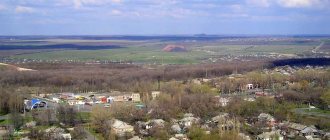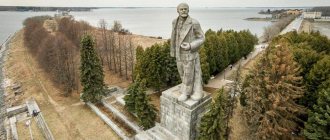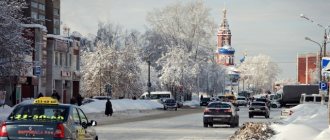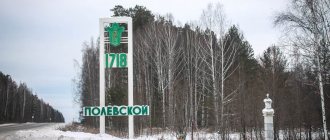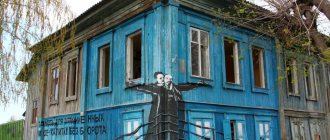History of Kiselevsk
The working-class city has a lot to do,
All its windows look into the distance.
So that our Kiselevsk never grows old,
We gave him our hearts.
M. Nebogatov
My city was born on January 20, 1936. The workers' village of Kiselevsk was transformed into the city of Kiselevsk by the Decree of the Presidium of the All-Russian Central Executive Committee. And the workers’ settlement itself appeared on November 1, 1932.
Historical documents indicate that in the 17th century, Teleut Turks lived on the territory of Kiselevsk. The names of the rivers speak about this: Kara-Chumysh - black river, Aba - father, Akchurla - holy, shining river, Kalzagai - red stone, Karmak - fishing rod, Surtaikha - red river, Taiba - cold river, Turgai - muddy river . All of them are of Teleut origin. Russians settled here in the 18th century.
The oldest settlement is the village of Cherkasovka. In 1715, Colonel Cherkasov arrived in the city of Kuznetsk from Tomsk with a large military team of 760 people. As a rule, ordinary people, including soldiers of that time, did not have surnames. The soldiers of Colonel Cherkasov's detachment had the right to take the surname of their commander. Having become Cherkasov, the retired soldier received a land plot and founded a village, which became known as Cherkasovka. It appeared between 1715 and 1750. Afonino appeared somewhat later. The village was founded by the peasant Afonin, after whose last name it was named. In 1882, the Church of the Holy Chief Apostles Peter and Paul was built in the village. The church was built at the expense of a local merchant and parishioners.
It is noteworthy that the larch for the construction of the temple was harvested on site, i.e., a deciduous forest grew nearby. At that time, the village had 99 households and 354 people lived, of which 171 were men and 183 women. The Afoninsky church parish consisted of 9 villages. In 1887, a parish school was opened here. The church had a library of 30 volumes. These were books of religious content. In 1913, the village of Afoninskoye became the center of the Romanovskaya volost, which was home to about three thousand people and included villages that have survived to this day: Aleksandrovka, Burlaki, Verkh-Chumysh, Iganino, Kutonovo, Starosergeevka and Cherepanovo.
The rapid growth and development of villages began after geologists discovered and explored the coals of the Prokopyevsko-Kiselevskoye coal deposit. In 1827-1828, this was done by mining engineer L. A. Sokolovsky, and later by L. I. Lutugin and the “Lutugins”: V. I. Yavorsky, P. I. Putov, A. A. Ganeev, A. A. Snyatkov , who explored the Kuznetsk coal basin from 1914 to 1916. 1916 is considered to be the year of the discovery of the Prokopyevsko-Kiselevskoye coal deposit.
In October 1917, industrial coal mining began. The archival document “Exploration for coal in the village of Kiseleva in 1917-1918” says: “to exploration in the vicinity of the village. Kiseleva (Cherkasova) began in early August 1917, and the actual exploration work was carried out until October. Exploration was mainly carried out on the custom wing of the Kiselyovo-Afoninskaya syncline, between the Surtaikha River in the south and the Tugai River in the north. The first main exploration line, about 200 fathoms long, located in the lower part of the left ridge of the Surtaikha River, directly above the village of Kiseleva, crossed seven working seams of coal with a thickness of 2 arshins to 10 fathoms. In winter, small coal mining was already underway for the needs of exploration and the local population.”
This is how the city’s very first coal enterprise appeared. This area later became a mining allotment of mine No. 12. Now the small adit, from which the first pounds of coal were extracted in 1917, has turned into a modern coal production facility with a capacity of 700 thousand tons. The oldest mine in the city, bearing the worthy title “Mine No. 12,” is part of the coal mine.
Therefore, the city of Kiselevsk was born as a city of coal, a city of miners.
And our coal is everywhere
And it’s me, the miner,
Breathed fire into him
Unquenchable life.
V. Izmailov
In 1936, 30,694 people lived in Kiselevsk and 13,000 people in the Kiselevsky district. In Kiselevsk there are 5 mines, a mechanical plant, the Afoninsky Kir, a construction office, an ORS, 9 schools. In 1937, the mine produced 2329.1 thousand tons of coal, which amounted to 13.5% of all coal production in Kuzbass. On January 1, 1940, the city had 49 industrial enterprises and a population of 51,844 people. On January 26, 1943, the city of Kiselevsk became part of the created Kemerovo region.
Kiselevsk on the map of Russia, geography, nature and climate
The city is located in the upper reaches of the Aba River, in the foothills of the Salair Ridge. The city of Prokopyevsk is 19 km south of Kiselevsk, Novokuznetsk is 58 km southeast, Kemerovo is 178 km north. City center coordinates 54°00′ N. and 86°38′ E. The area occupied by Kiselevsky is 120 sq. km.
The climate in the city is continental with long frosty winters and short cool summers. The hottest month is July. Its average daily temperature is +18.4°C. The coldest month is January. The average temperature during this period in the city is -15.8°C.
Heroes of the Second World War - residents of Kiselevsk
As soon as the call “everyone to defend the Motherland” sounded, hundreds of residents of Kiselevsk turned to the local military registration and enlistment office with a request to send them to the front. The war ended, 4,416 Kiselev residents did not return home, they fell on the battlefield. Eight Kiselev residents were awarded the title Hero of the Soviet Union.
1. Gorelikov Ivan Pavlovich, born in 1907 in the village of Avdyushino, Krasnoyarsk Territory, died in 1975. Sniper of the 29th Guards Rifle Regiment of the 12th Guards Division. The title of Hero of the Soviet Union was awarded on April 28, 1943. After the war he lived in Kiselevsk and worked as a watchmaker.
2. Tuigunov Leonid Naumovich, born October 5, 1919 in Krasnoyarsk. I spent my youth in Kiselevsk. In 1940 he graduated from the Chelyabinsk Military Aviation School of Observer Pilots. There were 229 successful combat missions. On November 5, 1944, he was awarded the title of Hero of the Soviet Union.
3. Kolpakov Petr Ivanovich, born in 1921, died in 1977. Guard senior sergeant, intelligence officer, received the title of Hero of the Soviet Union (Decree of February 27, 1945) for successfully conducting reconnaissance in the city of Inoroslavl (Poland), during which 1 general and 8 officers were captured. I spent my childhood and youth in Kiselevsk. He returned here after the war.
4. Chernykh Ivan Sergeevich, born in 1918 in Tomsk. In 1936 he worked at the Kiselevsky Machine Plant. In 1940 he graduated from the Novosibirsk Military Aviation Academy. He died on January 16, 1941 in the sky near Leningrad (Gudovo), directing a burning plane into an enemy column. On January 16, 1944, he was awarded the title of Hero of the Soviet Union.
5. Chumov Afanasy Gavrilovich, born on July 15, 1901 in the village of Bugry, Novosibirsk region, died on July 15, 1984. From 1941 to 1945 he was a gunner in a guards artillery regiment. In the battles near Siauliai on August 19, 1944, he accomplished a feat - he fought against 36 tanks with one combat crew. The title of Hero of the Soviet Union was awarded in 1945.
6. Buslov Fedor Vasilievich, born in 1921 in the village of Don-Nigachevka, Lipetsk region. I spent my youth in Kiselevsk. Pilot of the IL-2 attack aircraft, entered into air combat 56 times. For the battle near Sevastopol he was awarded the title of Hero of the Soviet Union.
7. Perepechin Petr Martynovich, born on January 2, 1915 in the village of Verkh-Paiva, Altai Territory, died on December 3, 1982. Company commander of the 465th Infantry Regiment of the 167th Infantry Division. He distinguished himself during the crossing of the Dnieper and during the capture of Kyiv. On January 10, 1944 he received the title of Hero of the Soviet Union.
8. Belyaev Irenei Fedorovich, born in 1914. Died on July 8, 1943 in the sky near Leningrad. Fighter pilot of the 27th Guards Aviation Regiment, flew 356 combat missions, shot down 17 aircraft, and fought 56 battles. On July 2, 1943, he was nominated for the title of Hero of the Soviet Union. In 1936, he lived and worked in Kiselevsk, working as an instructor for the city Komsomol committee. From here he went to the Perm School of Military Pilots.
Honorary citizens of Kisieleska
The history of any city is created by people. Our city was glorified by wonderful fellow countrymen. For special merits and outstanding contribution to the development of the city, for personal courage and heroism shown in the performance of official and civic duty, ten of our fellow countrymen were awarded the title “Honorary Citizen of the City of Kiselevsk”:
1. Rychkov Valentin Dmitrievich – rear admiral.
2. Ivanov Dmitry Ivanovich - holder of the Order of Glory of three degrees.
3. Chumov Afanasy Gavrilovich - Hero of the Soviet Union.
4. Zavrazhnov Yuri Vasilievich - Hero of Socialist Labor, Honorary Miner.
5. Safronov German Ivanovich – professor at Leningrad University, member of the Academy of Humanities.
6. Soldatov Alexey Efimovich - holder of the Order of Glory of three degrees.
7. Kalyuga Ivan Fedorovich - Hero of Socialist Labor.
8. Naidov Mikhail Ivanovich - former director of the Vakhrushev mine, is an honorary citizen of the Kemerovo region.
9. Sinyakov Grigory Fedorovich - former director of the Krasny Kuzbass mine, for several years he was the chairman of the city Council of People's Deputies, now the chairman of the founding Council of the charitable foundation.
10. Dranichnikov Alexander Mikhailovich – president of the company AIK Sokolovskaya.
On the basis of the Vakhrushev mine, founded in 1941, a large joint-stock investment company Sokolovskaya was formed in 1993, which in 2001 turned into a powerful holding company Sokolovskaya, headed by A. M. Dranichnikov. Today this company is known not only in Russia, but also far beyond its borders. The company's goal is the extraction, transportation and sale of coal. The set goal is being successfully achieved.
Sports life in Kiselevsk
Sports are loved and valued in Kiselevsk. Where else, if not in sports, can you strengthen your will and develop character? The city has good sports opportunities. The city has two sports complexes “Yunost” and “Rodnik”, a chess and checkers club named after Grandmaster Chigorin, the Shakhtar stadium, the “Birch Grove” ski resort and a new ski resort, the Center for Children and Youth Tourism and Local History, the “Salang” caving club, a station for young technicians, three children's and teenage clubs "Cosmos", "Russian Bear" and "Youth", a children's and youth sports school.
For the 70th anniversary of the city, the Shakhtar stadium was almost completely rebuilt, turning into the modern Shakhtar sports complex.
The city's athletes engage in 20 sports. The city has 30 masters of sports, and has its own champions of Siberia, Russia and even the world. The pride of Kiselevsk, its glory and greatness are, first of all, Plyukfelder R., Vakhonin A. - world champions in weightlifting; Dolmatov S. – world champion among youth chess; Sinitsky A. - silver and bronze medalist of the Kettlebell Lifting Championship and World Cup, two-time record holder in the clean and jerk.
Among the champions of lower rank are the names of athletes from various sports. Boxing: Ashikhmin O., Naumov D., Akhmatgatin A., Popov A., Dutov K. Cross-country skiing: Simonova T., Salnikova S., Bocharova E., Polosin A. Weightlifting: Shaykhattarov F., Kovshov A. Logunov Denis became an international master and Russian champion in Thai boxing. Polina Dontsova became the champion of the Russian Athletics Championship. There are 25 holders of the “Sports Valor of Kuzbass” badge in the city. Kiselev athletes will delight the city with their successes more than once.
Routes on the map of Kiselevsk. Transport infrastructure
There is a railway station in Kiselevsk. The Leninsk-Kuznetsky - Novokuznetsk highway passes through the city. You can use it to get to the roads leading to the following cities:
- Barnaul (371 km);
- Biysk (306 km);
- Tashtagol (211 km);
- Novosibirsk (326 km);
- Kemerovo (178 km);
- Tomsk (382 km);
- Krasnoyarsk (705 km).
By rail, trains pass through Kiselevsk in the direction of: Moscow, St. Petersburg, Kislovodsk, Adler, Anapa, Vladivostok, Novosibirsk, Bishkek, etc. Public transport in the city is represented by buses and minibuses. From the city bus station there are regular flights to the following cities:
- Prokopyevsk;
- Kemerovo;
- Belovo;
- Novokuznetsk;
- Tomsk and others.
Monuments
Monuments reveal to us unknown pages of the history of our city. On Lenin Street there is a monument to the founders of scientific communism, Karl Marx and Friedrich Engels. It is set in the 1960s, the author is unknown. The monument stands at the entrance to a small square. In the depths of the park, in the year of the 55th anniversary of the Victory over Nazi Germany, a stele was erected on which the names of Kiselev residents, Heroes of the Soviet Union, are forever imprinted.
On Sovetskaya Street, another historical place from the Civil War opens before our eyes. The monument is dedicated to those who defended Soviet power in Kuzbass in the fight against Kolchak. It is located in the city center near the former House of Technology, now the building of AIK Sokolovskaya. On the obelisk there are the words: “To the fighters for the establishment of Soviet power in Kuzbass, Pyotr Rudakov, Andrei Rudakov, Fyodor Portnyagin, Vasily Yuzhakov, Afanasy Yuzhakov, shot in May 1917, from Komsomol members and the youth of the city.” On October 28, 1959, the remains of the partisan heroes were reburied here, in this place, and on September 19, 1963, a monument was erected above the brotherly cemetery. Its construction began in 1961 according to the design of the artist V.I. Karasev. It is an obelisk on a square pedestal, on one side there is a bas-relief of five partisan heroes, on the other - text. The monument ends with a spire with a star. Monument in the city center, monument in the heart of the city
One of the attractions of the Mine No. 12 area is Victory Square. Standing in this place, I would like to once again remember the courage and heroism of the Soviet people, who fought a merciless battle with the Nazis for 1,418 days and nights, and all these days, from the first to the last hour, our city of Kiselevsk marched in a single formation. Victory Square has become one of the favorite places for residents and guests of the city. In the center of the square stands a monument - an eight-meter sculpture of a victorious warrior. On the pedestal there is an inscription: “The brave have no death, they have immortality”, below: “To the residents of Kiselev who died during the Great Patriotic War of 1941-1945. ", on the right side of the pedestal are the words: "Dedicated to courage." In 1967, the city held a competition for the best design of a monument to the heroes of Kiselev. The city commission summed up the results and recognized the obelisk project “Dedicated to Courage” by the authors-brothers Selishchev and N. Kuleshov as the best. On October 28, 1967, a city meeting was held dedicated to the laying of the monument. The monument was opened on May 9, 1970 to mark the 25th anniversary of the Victory. At the foot of the monument there is a capsule with the names of the fallen heroes.
At the entrance to the machine plant named after I. S. Chernykh there is a bust of the pilot Hero of the Soviet Union Ivan Sergeevich Chernykh. It was installed on the initiative of Komsomol members of the plant in 1965, in the year of the 20th anniversary of the Victory over Nazi Germany. At school No. 24 there is a museum dedicated to I. S. Chernykh.
The monument-stella “Grieving Mother” was opened on November 4, 1968 and is dedicated to the workers of the machine plant who died in battles with the Nazi invaders. Their names are carved in gold letters on the marble slab, and on the top there are the words: “They went to death and gained immortality.” On the left is a bronze figure of a woman-mother. She lays a laurel wreath at the foot of the slab, personifying the image of the Motherland, which remembers her sons, mourns and is proud of their feat.
A little chronology
To the table of contents of the book “Kiselevsk”.
1790 The first mention of coal rocks found by travelers on the site of the villages of Afonino and Cherkasovo.
1836 Engineer-captain N. Sokolovsky, studied the chemical and metallurgical properties of Afonino coal. Later, already in 1842, he wrote an article in the Mining Journal about the possibility of using it in iron factories.
1844 The village of Afonino was visited by a geological expedition led by Moscow University professor Grigory Efimovich Shchurovsky.
1850 In Afonino, minor coal mining began from small adits for the needs of the Tomsk Ironworks. It ceased in 1864, with the closure of the plant.
1914 Geologists, under the leadership of the outstanding geologist L. I. Lutugin, and since 1915 - his successor V. I. Yavorsky, are studying the coal reserves of Kuzbass, including the Kiselev-Afoninsky deposit.
1917 October 15. The first 752 pounds of coal were produced from open-pit coal mine No. 1. This day is considered the birthday of the Kiselevsky mine.
1918 The 25th of January. A meeting of workers from the Prokopyevsk and Kiselevsky mines decided to petition the Soviet government for the nationalization of coal enterprises belonging to the Kopikuz joint-stock company.
1918 June. The villages of Afonino and Cherkasovo were occupied by the White Czechs and White Guards.
1919 December. The Kolchakites were expelled from the Kuznetsk district. Soviet power has been restored.
1020 January 20th. The Kiselevsky mines are included in the established association of the coal industry of Siberia - Sibugol.
1920 February. In the village of Cherkasovo (Kiselevskie mines), the first party cell of 20 people was created.
1920 May. The first Komsomol cell was created in the village of Cherkasovo.
1920 May. The Afoninsk meteorological station was created.
1920 The village council of the village of Cherkasovo was elected. Ivan Egorovich Selivanov became its chairman.
1920 In the Akchurlinsky ravine there is an adit named after Sverdlov along the Gorely seam.
1920 An agricultural commune named after Rosa Luxemburg was formed in the village of Cherkasovo.
1921 August. The propaganda train named after Vladimir Ilyich Lenin made a multi-day stop at the Kiselevsky mines.
1921 the 25th of October. The construction of the Kolchugino branch of the Kolchugino-Usyaty railway has been completed. The first train of coal from the Kiselyovo-Prokopyevsk mines began its journey.
1923 In Kiselevsk he was elected as a sub-district with subordination to the Prokopyevsky district party committee.
1924 September. According to the resolution of the Kuzbasstrust management, the Kiselevsky mine is mothballed.
1927 8 August. On the basis of the concession agreement dated November 14, 1925 and an additional agreement dated June 18, 1927, concluded by the Soviet government with the joint-stock company Lena Goldfields Limited, the Kiselevsky coal mines, owned by the trust "AIK - Kuzbass" (Kuzbassugol), were transferred into concession to the joint-stock company "Lena Goldfields."
1931 January. As a sign of proletarian solidarity with the striking miners of the Ruhr and Wales, rallies were held at the Kiselevsk mines on all shifts. The Kiselevsky miners donated their one-day earnings to the strike relief fund.
1931 The mine has created UNSH - the management of the construction of new mines of the Kuzbassugol trust. This year five adits were put into operation.
1932 The first mines “Naklonnaya No. 1” and “Capital No. 1” were laid.
1932 Nov. 1. On the site of the villages of Afonino and Cherkasovo, the Kiselevsky workers' settlement was formed and a village council was elected.
1932 In a vacant lot, outside the village of Cherkasovo, the first workshop of the Kiselevsky Mechanical Plant, now the Ivan Chernykh Machine Plant, went into operation.
1932 The Kiselevsky Mining Party Committee was created, subordinate to the Prokopyevsky City Party Committee.
1933 The “Naklonnaya-2” and “Naklonnaya-3” mines are being laid.
1933 April 10th. The first issue of the newspaper “Into the Battle for Coal” was published. Comrade Shornina was approved as editor.
1933 October. The Afoninsky brick began to operate - it was laid out on the façade of the first tent stove.
1934 The inclined mines No. 4 and 5 were laid.
1935 The Kiselevsky Machinery Plant is fully operational.
1936 January 20th. The workers' village of Kiselevsky was renamed the city of Kiselevsk by resolution of the All-Russian Central Executive Committee.
1936 11th of March. The first regional conference of the Kiselevsky district committee took place. The district included: the city of Kiselevsk, 6 rural councils allocated from the Prokopyevsky district.
1936 November. At mine No. 3 (now Kiselevskaya), the first test of the shield structure of mining engineer N.A. Chinakal was carried out for mining thick, steeply dipping seams.
1937 May 4-10. The first city party conference of the city of Kiselevsk was held.
1940 The Surtaikha mine came into operation.
1941 January. One of the largest mines in Kuzbass, the Kapitalnaya No. 1 mine (now named after Vakhrushev), was put into operation, the first mine in Kiselevsk with a vertical shaft.
1941 November. Kiselevsky was created on the basis of evacuated factories from Donbass and Tallinn.
1943 1st of February. The "Far Mountains" mine went into operation.
1944 Mine No. 7-a was put into operation.
1947 The mining technical school accepted its first students.
1948 August. For the first time in the country, Miner's Day was celebrated; 114 of the city's best miners were awarded the title "Honorary Miner".
1950 The general plan for the development of the city has been approved.
1951 One of the largest mines, Taibinskaya, came into operation with a workers’ village.
1952 The Palace of Pioneers is open for schoolchildren of the city.
1953 July. The first coal mine in the city, Kiselevsky, came into operation.
1955 May. The South Abinsk experimental-industrial station “Podzemgaz” began producing industrial gas.
1955 December. The Vakhrushevsky coal mine produced the first tons of coal.
1956 1st of January. An act was signed on the commissioning of existing mines No. 12, called No. 1-2 until reconstruction.
1958 Electrical mechanic of mine No. 4-5 Rudolf Plückfelder won the title of world champion at the World Barbell Championships in Warsaw.
1959 1st of January. Based on the combined mines No. 7-a and 7-b, mine No. 7 was created.
1959 A monument was erected to the fighters who died for the establishment of Soviet power in Kuzbass. 1962 The People's Academic Choir of the Miners' House of Culture, together with other best groups in the region, participated in the theatrical concert “Poem about Kuzbass”, shown in the capital of our Motherland - Moscow.
1963 January. The new widescreen and later widescreen cinema “Russia” opened its doors to viewers.
1963 On the square near school No. 14 there is a monument to V.I. Lenin.
1963 September. A. Vakhonin won the gold medal at the Stockholm World Weightlifting Championships in the bantamweight division.
1964 January. The first concentrate was produced by a new powerful enrichment plant - Kiselevskaya Central Processing Plant.
1964 June. The Far Mountains mine, the first in the city, was switched to a five-day work week with two days off.
1964 September 30th. The beginning of large-panel housing construction in the city.
1964 October. The mining team of E.R. Mityashin from the Taibinskaya mine extracted 55,309 tons of coal from under the shield in 31 working days.
1964 December. The first coal was produced by the Karagailynskaya 1-2 mine, the most mechanized in the basin.
1965 August. Yu. V. Zavrazhnov’s clearing brigade was among the first in Kuzbass to complete the seven-year plan, delivering 1 million tons of coal to the Motherland.
1966 72 miners of the mine were awarded orders and medals of the Soviet Union for high production achievements in the seven-year period. Yu. V. Zavrazhny, a miner at mine No. 13, was awarded the title of Hero of Socialist Labor.
1966 March. The team of A. S. Zakrevsky from the Vakhrushev mine produced 33,024 tons of coal from under a flexible metal ceiling in 31 working days, setting a Kuzbass record.
1966 A group of Kiselevsk miners went to the Democratic Republic of Vietnam to restore the Vang-Zian mine.
1966 The reconstruction of the Shakhtar stadium, which can accommodate up to 8 thousand spectators, has been completed.
1966 30 June. The Kiselevsky brewery came into operation.
1966 December. A coal mining trust was formed in the city.
1967 November. In honor of the 50th anniversary of the Great October Socialist Revolution, Kerchenskaya Street was named 50 Years of October Avenue.
1967 Following the example of leading teams, a competition was launched in the city under the motto “Everyone in his own workplace is an economist.”
1968 October. A team of miners at the Taibinskaya mine, led by Mikhail Ivanovich Bragin, set an all-Union record for coal production from under the shield, extracting 65,120 tons.
1968 December. The Kiselevskaya shoe factory was put into operation.
1970 May. To commemorate the 25th anniversary of the Victory over Nazi Germany, the square located on 50 Let Oktyabrya Avenue was named after Victory Square.
1970 Hero of the Soviet Union Afanasy Gavrilovich Chumov, a personal pensioner, and captain 1st rank Valentin Dmitrievich Rychkov were awarded the title “Honorary Citizen of the City of Kiselevsk.”
1970 9th May. A monument to the Kiselev residents who died during the Great Patriotic War was unveiled on Victory Square.
1970, 700 Kiselev residents were awarded the medal “For Valiant Labor, In Commemoration of the 100th Anniversary of the Birth of V. I. Lenin.”
1970 July, the Kiselevskugol trust was liquidated. The city's mines became part of the Prokopyevskugol plant.
1971 For their selfless work in the Eighth Five-Year Plan, 500 workers of Kiselevsk were awarded orders and medals of the Soviet Union. Four of them are the foreman of the Karagaylinskaya-1-2 mine treatment complex V.P. Sharkov, the foreman of the Krasnokamenskaya mine I.F. Kalyuga, the foreman of the Kiselevsky coal mine excavator crew I. Z. Lipov, the foreman of assemblers V.K. Marunin - awarded the title of Hero of Socialist Labor.
